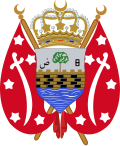
Back الإمامة الزيدية Arabic যায়দী ইমামত Bengali/Bangla Zaidites del Iemen Catalan Rassiden German امامت زیدی Persian Jemen uralkodóinak listája Hungarian Daftar Raja Yaman ID Zaidi imamatas Lithuanian Władcy Jemenu Polish Список имамов Йемена Russian
| Monarch of Yemen | |
|---|---|
 | |
| Details | |
| First monarch | al-Hadi ila'l-Haqq Yahya |
| Last monarch | Muhammad al-Badr |
| Formation | c. 897 |
| Abolition | 1 December 1970 |
| Residence | Dar al-Hajar, Sanaa, Yemen |
| Pretender(s) | Ageel bin Muhammad al-Badr |
The Imams of Yemen, later also titled the Kings of Yemen, were religiously consecrated leaders (imams) belonging to the Zaidi branch of Shia Islam. They established a blend of religious and temporal-political rule in parts of Yemen from 897. Their imamate endured under varying circumstances until the end of the North Yemen civil war in 1970, following the republican revolution in 1962. Zaidi theology differs from Isma'ilism and Twelver Shi'ism by stressing the presence of an active and visible imam as leader. The imam was expected to be knowledgeable in religious scholarship, and to prove himself a worthy headman of the community, even in battle if this was necessary. A claimant of the imamate would proclaim a "call" (dawah), and there were not infrequently more than one claimant.[1]
- ^ Jane Hathaway, A Tale of Two Factions; Myth, Memory, and Identity in Ottoman Egypt and Yemen. New York 2003, pp. 79–81.